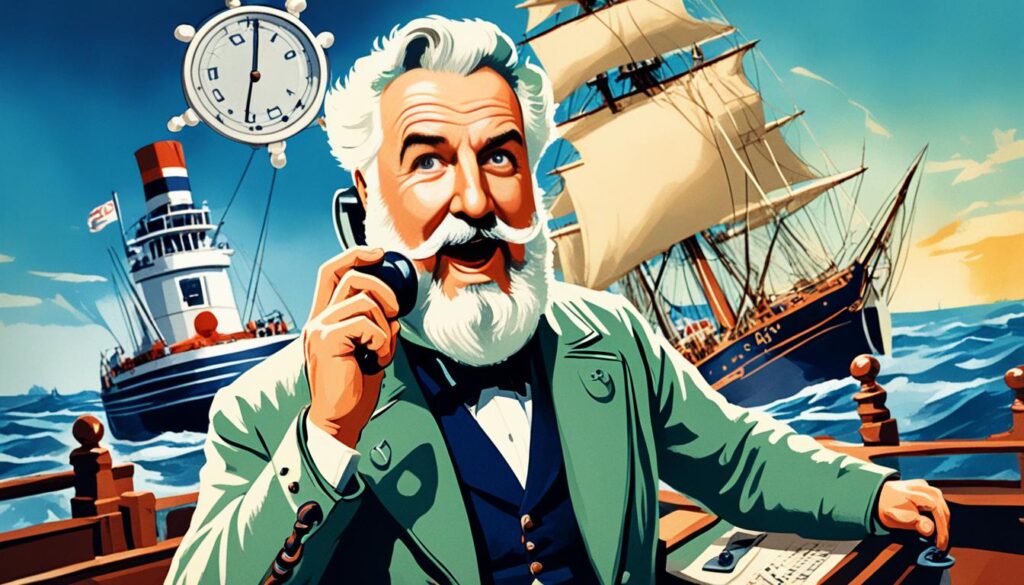When you answer your phone today, you might say “hello” without thinking. But did you know Alexander Graham Bell, the inventor of the phone, had another idea? He thought “Ahoy” should be the way we answer calls. This unique greeting comes from the early days of phone use.
Bell took his idea from the sea, where “ahoy” was used to call out to ships. This term has been around for hundreds of years. Even though Bell liked “ahoy,” it didn’t become the main way we answer phones. Instead, “hello” became the standard greeting we use today.
Key Takeaways
- Alexander Graham Bell preferred “ahoy” as a telephone greeting
- “Ahoy” has nautical origins and a long history
- Bell’s choice didn’t become the standard greeting
- “Hello” eventually became the popular phone answer
- Early telephone etiquette was still evolving
The Origin of Bell’s “Ahoy” Phone Greeting

Alexander Graham Bell chose “ahoy” for early phone greetings because of its maritime history. This word comes from the sea and was used by sailors. It started from the Middle English “Hoy!” used to call cattle in the 14th century.
The first time “hoy” was written down was in “Piers the Ploughman” by William Langland in 1393. Sailors later changed it to “hoay,” as noted by Scottish poet William Falconer in 1769. Bell thought “ahoy” was perfect for starting phone calls because it was loud and clear.
Bell wanted a standard way to start phone calls with early telephone greetings. He thought “ahoy” was great for starting a conversation, just like at sea. This idea shows Bell’s creative thinking in communication technology. It highlights his vision for the future of phones.
The Rise of “Hello” as the Standard Telephone Greeting
Alexander Graham Bell wanted “ahoy” to be the standard greeting, but Thomas Edison made “hello” the top choice. Edison, a big name in phone etiquette, pushed for “hello” as the best way to answer calls. This simple word was first seen in 1827 but didn’t become a common greeting until the phone came along.
Edison had a big impact on phone culture. He urged users of his phones to say “hello” when they answered. This quickly spread through early phone networks. The word got a big boost when it was listed in the first phone book by the District Telephone Company of New Haven, Connecticut, in 1878. This was a key moment in phone, suggesting a “firm and cheery ‘hulloa’” to start calls.
As more people used phones, “hello” became the top greeting. It became a key part of phone etiquette, changing how we talk on the phone. Thanks to Edison and its wide use, “hello” has been the go-to greeting for over a hundred years. It beat out Bell’s “ahoy” and became a key part of our daily chats.
Legacy and Cultural Impact of Bell’s Proposed Greeting
Bell’s “Ahoy” phone greeting didn’t stick for phone calls, but it made a mark. This piece of vintage telecommunications history still affects us today. The word “ahoy” is still used in sea talk and everyday speech in some places.
In the Czech Republic and Slovakia, “ahoj” is a common way to say hello. This shows how Bell’s idea spread beyond just phones. TV has also kept “ahoy” alive. Fans of “The Simpsons” might remember Mr. Burns answering his phone with “Ahoy-hoy,” a tribute to Bell’s greeting.
These examples show us that early phone history still interests people. Bell’s “Ahoy” greeting reminds us of how far we’ve advanced in talking over distance. It’s a fun look back at how we’ve connected with each other. Even though it’s not used in phone calls anymore, it’s still part of our communication story.

Leave a Reply